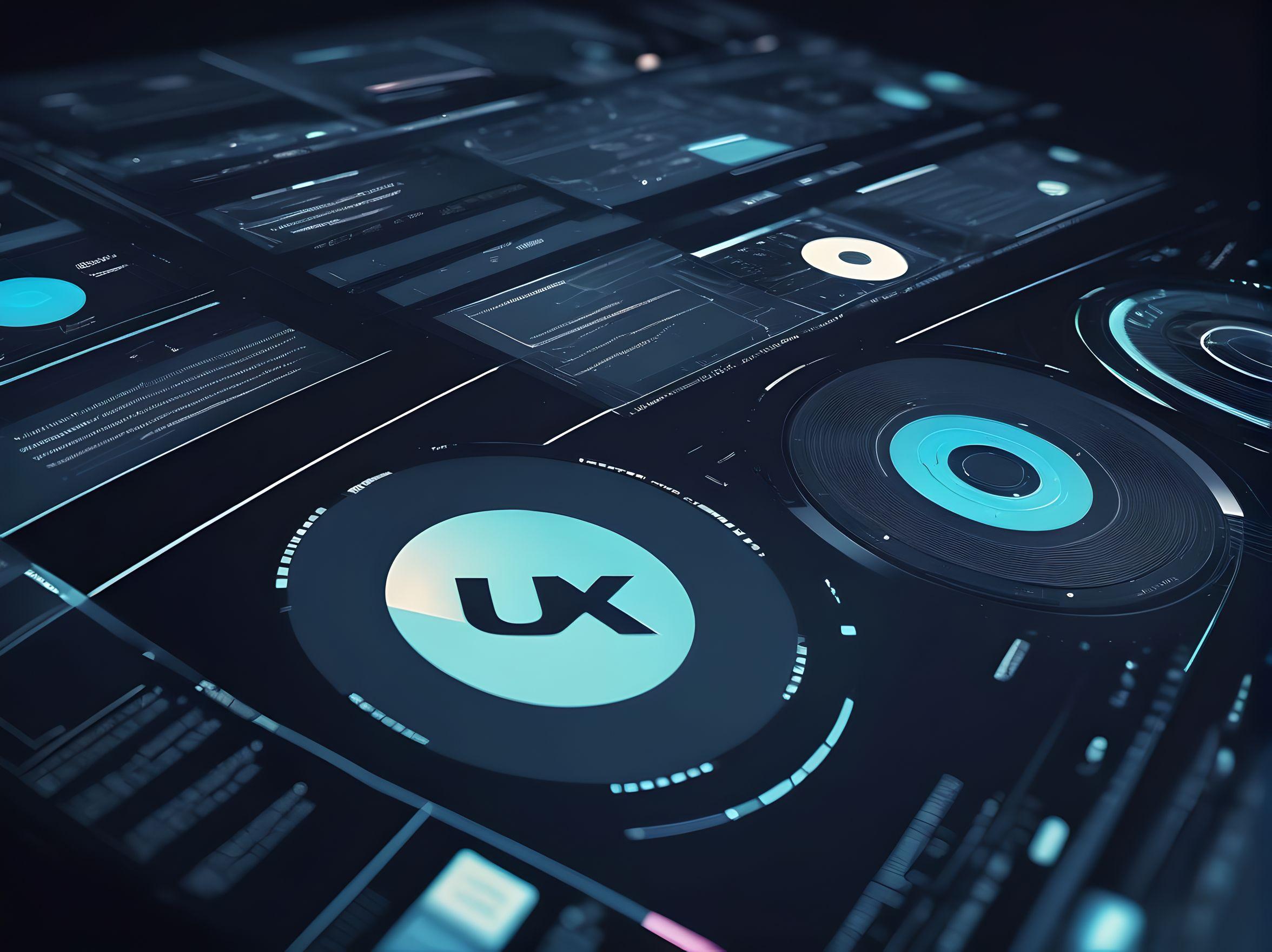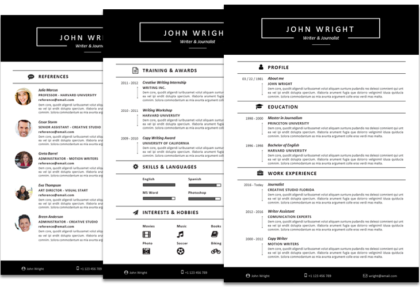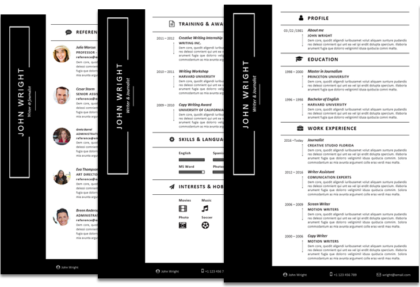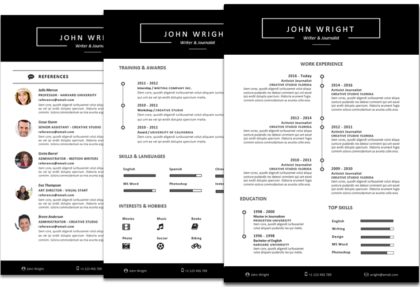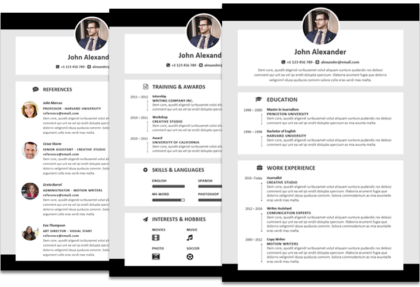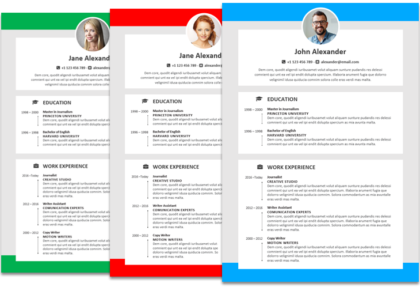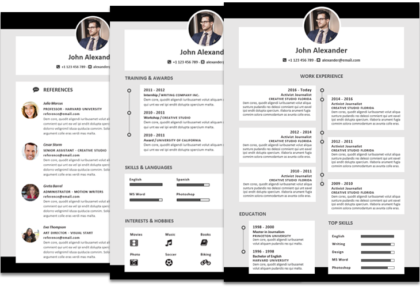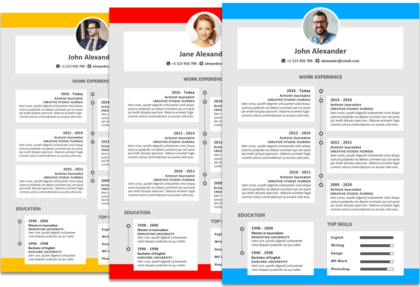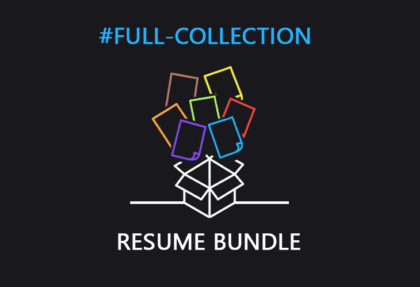UX Designer: A Comprehensive Guide
Embarking on a journey in the dynamic field of User Experience (UX) Design can be both exciting and challenging. Whether you are a seasoned professional looking to refine your skills or a newcomer eager to step into this innovative realm, understanding the ins and outs of UX design is crucial. In this comprehensive guide, we will delve into the top most asked questions about the position of a UX Designer, shedding light on key aspects of this multifaceted role.
If you’re interested in pursuing this position and are preparing your resume to apply for a job, here’s some help.
Please consider downloading our UX Designer: Resume Template and Cover Letter.
1. What does a UX Designer do?
In the ever-evolving landscape of digital experiences, User Experience (UX) Designers play a pivotal role in shaping how users interact with products and services. But what does a UX Designer actually do?
At its core, a UX Designer is responsible for crafting digital experiences that users find intuitive, engaging, and enjoyable. From the initial stages of research to the final stages of prototyping, UX Designers ensure that every aspect of a product is user-centric.
At its essence, a UX Designer is a problem solver, an advocate for the end user, and a creative mind dedicated to crafting seamless, intuitive, and enjoyable digital interactions. Their primary focus is on understanding the needs, behaviors, and preferences of users through meticulous research.
This research forms the foundation for the UX Designer’s work, guiding them in creating information architectures, wireframes, and prototypes. These tangible representations help visualize the structure and flow of a digital product, ensuring that it meets the needs of the target audience.
Interaction design is a key facet of their responsibilities, encompassing the creation of interfaces that are not only visually appealing but also functional and easy to navigate. By employing principles of visual hierarchy, typography, and color theory, UX Designers enhance the overall aesthetics of digital products.
Usability testing is another crucial aspect of a UX Designer’s role. By gathering user feedback and analyzing how individuals interact with prototypes, designers identify potential pain points and areas for improvement. This iterative process ensures that the final product aligns closely with user expectations.
Collaboration is integral to the UX design process. UX Designers work closely with cross-functional teams, including developers, product managers, and stakeholders, fostering effective communication to bring design concepts to life. This collaboration ensures that the end product aligns not only with user needs but also with broader business objectives.
Advocacy for accessibility and inclusive design is a hallmark of a UX Designer’s approach. By incorporating best practices, they strive to make digital experiences accessible to users of all abilities and backgrounds, promoting inclusivity and user satisfaction.
In a nutshell, a UX Designer is a storyteller, weaving together insights from user research, the principles of design, and the goals of the business to create a narrative that resonates with the end user. As technology continues to advance and user expectations evolve, the role of the UX Designer remains at the forefront of delivering meaningful and delightful digital experiences. Their work goes beyond pixels and interfaces; it’s about understanding, empathy, and the art of crafting experiences that leave a lasting positive impact.
2. How to become a UX Designer?
Embarking on the journey to become a User Experience (UX) Designer is an exciting endeavor that requires a blend of creativity, technical proficiency, and a deep understanding of human behavior. If you’re passionate about creating digital experiences that resonate with users, here’s some info on how to embark on the path to becoming a UX Designer.
Becoming a UX Designer typically involves a combination of education and hands-on experience. Many professionals start with a relevant degree in design, psychology, or a related field. Supplementing this with online courses, workshops, and practical projects helps build a robust skill set.
Firstly, education plays a pivotal role. While a formal degree in design, psychology, or a related field can provide a solid foundation, it’s not the only route. Many successful UX Designers also emerge from diverse educational backgrounds, often supplementing their learning with specialized courses and workshops.
Building a robust skill set is crucial. UX Designers need to be proficient in various disciplines, including user research, information architecture, interaction design, visual design, and usability testing. Online platforms such as Coursera, Udacity, and LinkedIn Learning offer courses ranging from beginner to advanced levels, providing opportunities to acquire and refine these skills.
Practical experience is invaluable. Engaging in real-world projects, whether through internships, freelance work, or personal projects, allows aspiring UX Designers to apply theoretical knowledge in practical scenarios. This hands-on experience not only hones skills but also helps build a compelling portfolio—a key asset in the competitive field of UX design.
Networking and community involvement are essential components of a successful UX design journey. Joining UX design communities, attending conferences, and connecting with professionals in the field provides valuable insights, mentorship opportunities, and a sense of the industry’s pulse.
A well-crafted portfolio is the key to showcasing your skills and landing your first UX Design role. Your portfolio should include a diverse range of projects, demonstrating your ability to solve different design challenges and cater to various user needs. Each project should tell a story, outlining your process from research to the final design.
Lastly, stay curious and adaptable. The field of UX design is dynamic, with technologies and methodologies constantly evolving. Embrace a mindset of continuous learning, stay informed about industry trends, and be willing to adapt your skills to meet the ever-changing demands of the digital landscape.
Becoming a UX Designer is a journey marked by creativity, curiosity, and a commitment to understanding and improving the user experience. By combining education, practical experience, networking, and a perpetual thirst for knowledge, aspiring UX Designers can pave a fulfilling path towards contributing to the creation of meaningful and impactful digital interactions.
3. What skills are required for a UX Designer?
In the dynamic and user-centric field of User Experience (UX) Design, possessing a diverse and well-rounded skill set is paramount to success. A UX Designer is not merely a creator of visually appealing interfaces but a problem solver and advocate for the end user. So, what skills are required for a UX Designer to navigate this multifaceted role?
First and foremost, a UX Designer must be adept at user research. This involves the ability to conduct interviews, surveys, and usability testing to gain deep insights into user behaviors, needs, and preferences. This foundation of understanding is crucial for shaping design decisions.
Information architecture is another key skill. UX Designers must have the ability to create clear and effective structures for digital products. This includes developing user flows, wireframes, and prototypes to visualize and iterate on design concepts, ensuring a seamless user experience.
Interaction design, closely related to visual design, requires a keen eye for aesthetics and a deep understanding of how users interact with digital interfaces. UX Designers need to create interfaces that not only look good but are also intuitive and user-friendly.
Usability testing is an essential skill for validating design decisions. UX Designers must be able to plan and conduct usability testing sessions, analyze the results, and iterate on designs based on user feedback. This iterative process ensures that the final product aligns closely with user expectations.
Effective communication and collaboration skills are integral to a UX Designer’s success. Working closely with cross-functional teams, including developers and stakeholders, requires the ability to articulate design concepts, justify decisions, and incorporate valuable feedback.
Advocacy for accessibility and inclusive design practices is becoming increasingly important. UX Designers need to ensure that digital products are accessible to users of all abilities and backgrounds, promoting inclusivity and a positive user experience for everyone.
Proficiency in tools is a practical necessity. UX Designers commonly use industry-standard tools such as Figma, Adobe XD, Sketch, and InVision for creating designs and prototypes. Staying current with these tools is essential for effective collaboration and seamless design workflows.
Problem-solving skills are at the core of UX design. Designing solutions that address user needs while aligning with business goals requires critical thinking, creativity, and the ability to navigate challenges in the design process.
In a nutshell, the skills required for a UX Designer are a diverse blend of research, design, communication, and problem-solving capabilities. The ever-evolving nature of technology and user expectations necessitates a commitment to continuous learning and adaptation. A successful UX Designer embraces this dynamic environment, leveraging their skills to create digital experiences that resonate with and delight users.
4. What is the difference between UX and UI design?
In the realm of digital design, the terms User Experience (UX) Design and User Interface (UI) Design are often used interchangeably, leading to some confusion. However, these two disciplines, while closely related, have distinct focuses and responsibilities.
While UX (User Experience) design focuses on the overall user journey and satisfaction, UI (User Interface) design is more concerned with the visual elements and aesthetics of a product. In essence, UX design addresses how a product feels, while UI design deals with how it looks.
User Experience (UX) Design revolves around the holistic experience a user has with a product. It encompasses every aspect of the user’s interaction, from the moment they first encounter the product to their ongoing engagement. UX Designers are concerned with understanding the user’s needs, behaviors, and emotions, ensuring that the overall journey is seamless, intuitive, and enjoyable. Their goal is to optimize the entire user experience, often involving research, wireframing, prototyping, and usability testing.
On the other hand, User Interface (UI) Design deals specifically with the visual elements of a product. UI Designers focus on crafting the look and feel of interfaces to create a visually appealing and cohesive design. They are concerned with elements such as color schemes, typography, iconography, and overall aesthetics. UI Designers work to ensure that the user interface is not only visually pleasing but also aligns with the brand and effectively communicates the functionality of the product.
While UX Design is about the entire user journey and the overall experience, UI Design is more focused on the specific design elements that users interact with. The two disciplines are interconnected and collaborate closely, with the goal of creating a product that not only looks good but also provides a positive and meaningful experience for the user.
UX Design encompasses the broader user experience, addressing functionality, usability, and emotional engagement. UI Design, a subset of UX, specifically deals with the visual elements, enhancing the aesthetic appeal and ensuring a cohesive and user-friendly interface. Both disciplines are essential for creating digital products that resonate with users and deliver a seamless and visually pleasing experience.
5. Can you provide UX Designer job interview tips?
Nailing a UX Designer job interview requires a combination of showcasing your portfolio, discussing your design process, and highlighting how your skills align with the company’s needs. Be prepared to discuss specific projects, challenges faced, and how you overcame them.
**Navigating Success: UX Designer Job Interview Tips**
Embarking on a job interview as a UX Designer requires a strategic approach to showcase your skills and align with the company’s vision. Here are some essential tips, presented in bullet points, to help you excel in your UX Designer job interview:
Research the Company
– Understand the company’s products, services, and design philosophy.
– Familiarize yourself with recent design initiatives and their target audience.
Thoroughly Review Your Portfolio
– Select projects that demonstrate a diverse skill set.
– Clearly articulate your role, challenges faced, and the impact of your design decisions.
Emphasize Collaboration
– Highlight your ability to work effectively with cross-functional teams.
– Discuss your experience collaborating with developers, product managers, and stakeholders.
Showcase Problem-Solving Skills
– Discuss how you’ve overcome challenges in previous projects.
– Provide insights into your decision-making process and creative problem-solving approach.
Discuss Your Design Process
– Clearly articulate your approach to user research and prioritizing features.
– Share methods for ensuring a user-friendly interface and validating design decisions.
Adaptability and Continuous Learning
– Illustrate your commitment to staying updated on industry trends.
– Mention relevant courses, workshops, or conferences you’ve attended for ongoing professional development.
Soft Skills Matter
– Highlight communication skills, empathy, and a passion for understanding user perspectives.
– Demonstrate your ability to articulate design concepts in a clear and compelling manner.
Prepare for Technical Questions
– Be ready to discuss your understanding of UX principles and methodologies.
– Showcase your technical proficiency in areas such as wireframing, prototyping, and usability testing.
Ask Thoughtful Questions
– Demonstrate your genuine interest in the role by asking questions about the company’s design processes and future projects.
– Inquire about the team dynamics and how UX design contributes to the overall business strategy.
Present a Professional Demeanor
– Dress appropriately for the interview.
– Maintain good eye contact and offer a firm handshake.
Follow Up Post-Interview
– Send a personalized thank-you email expressing your gratitude for the opportunity.
– Reiterate your enthusiasm for the position and briefly mention key points discussed during the interview.
By integrating these tips into your preparation strategy, you can enter your UX Designer job interview with confidence and demonstrate not only your technical prowess but also your alignment with the company’s goals and values.
6. What are the key responsibilities of a UX Designer?
In the realm of digital design, User Experience (UX) Designers play a crucial role in shaping the interaction between users and digital products. Their responsibilities encompass a broad spectrum, focusing on creating experiences that are intuitive, engaging, and user-centric.
Key responsibilities include conducting user research, creating information architectures and wireframes, designing interactive prototypes, collaborating with cross-functional teams, and advocating for accessibility and inclusive design practices.
One of the primary responsibilities of a UX Designer is user research. Before starting on the design process, they delve into understanding the target audience. This involves conducting interviews, surveys, and usability testing to gain valuable insights into user behaviors, preferences, and pain points.
Once armed with user insights, UX Designers move into the realm of information architecture. They are tasked with creating clear and effective structures for websites or applications. This involves developing user flows, wireframes, and prototypes that serve as the blueprint for a seamless and intuitive user journey.
Interaction design is another cornerstone of a UX Designer’s responsibilities. This involves designing the interactive elements of a digital product, ensuring that users can navigate through it effortlessly. From button placements to transitions, every detail is meticulously crafted to enhance the overall user experience.
Visual design is the aesthetic aspect of a UX Designer’s role. While distinct from graphic design, it involves applying principles of visual hierarchy, typography, and color theory to create visually appealing interfaces. The goal is to strike a balance between aesthetics and functionality.
Usability testing is an integral part of the UX design process. Designers plan and conduct testing sessions to observe how users interact with prototypes, identifying areas for improvement. This iterative process ensures that the final product aligns with user expectations and preferences.
Collaboration is at the heart of a UX Designer’s role. They work closely with cross-functional teams, including developers, product managers, and stakeholders. Effective communication is essential as designers articulate their design concepts, incorporate feedback, and ensure alignment with broader business goals.
Advocacy for accessibility and inclusive design practices is a growing responsibility for UX Designers. Ensuring that digital products are usable by individuals of all abilities is not only ethically important but also aligns with legal standards.
The key responsibilities of a UX Designer span from understanding user needs through research to crafting intuitive information architectures, designing engaging interfaces, and advocating for accessibility. This multifaceted role requires a blend of technical proficiency, creativity, and a deep understanding of human psychology to create digital experiences that leave a lasting positive impact on users.
7. Are there any online courses for learning UX design?
Staying abreast of the latest methodologies and tools is crucial. Fortunately, the digital age has ushered in a wealth of online courses that cater to both aspiring and seasoned UX Designers, offering a convenient and flexible way to enhance skills and stay competitive in the industry.
Numerous online platforms provide a diverse range of UX design courses, accommodating learners at various skill levels. Among these, industry-renowned platforms such as Coursera, Udacity, and LinkedIn Learning offer comprehensive courses taught by seasoned professionals and educators.
For beginners, foundational courses often cover the basics of UX principles, research methodologies, and design thinking. These courses provide a solid introduction, helping learners understand the core concepts that underpin effective user experience design.
Aspiring UX Designers looking for more in-depth knowledge can delve into intermediate and advanced courses. These cover topics such as interaction design, prototyping, usability testing, and information architecture. Additionally, courses on specific tools commonly used in the industry, like Figma, Adobe XD, or Sketch, are widely available.
One notable advantage of online UX design courses is the flexibility they offer. Learners can access course materials at their own pace, fitting their studies around existing commitments. This accessibility is particularly beneficial for working professionals seeking to upskill or transition into the field of UX design.
Furthermore, many courses incorporate hands-on projects and real-world applications, allowing learners to apply theoretical knowledge to practical scenarios. This experiential learning approach enhances the effectiveness of the courses, enabling participants to build a portfolio that showcases their newfound skills.
In addition to structured courses, there are often forums, discussion boards, and community spaces where learners can interact with instructors and fellow students. This collaborative aspect fosters a sense of community, providing opportunities for networking, sharing insights, and seeking advice from experienced professionals.
As the demand for UX Designers continues to grow, investing in online courses becomes not just an option but a strategic career move. Whether you’re taking your first steps into the world of UX design or looking to refine your expertise, the plethora of online courses available ensures that there is something for everyone. The key lies in selecting courses that align with your goals, dedicating time to continuous learning, and leveraging the wealth of resources at your fingertips to shape a successful career in UX design.
8. How much does a UX Designer earn?
Salaries for UX Designers vary based on experience, location, and the employing organization. On average, entry-level positions may start around $60,000, while experienced professionals in high-demand markets can earn well above $100,000 annually.
9. What tools do UX Designers use?
UX Designers use a variety of tools to create designs and prototypes. Industry-standard tools include Figma, Adobe XD, Sketch, and InVision. Staying familiar with these tools is crucial for effective collaboration and seamless design workflows.
The creative process is significantly aided by a plethora of tools that empower designers to bring their visions to life. These tools serve various purposes, from ideation and wireframing to prototyping and collaboration. As the field evolves, so too does the landscape of UX design tools, with each offering unique features catering to different aspects of the design process.
One of the fundamental tools in a UX Designer’s toolkit is the prototyping tool. Platforms such as Figma, Adobe XD, Sketch, and InVision facilitate the creation of interactive prototypes that simulate user interactions with a digital product. These tools enable designers to test and refine their designs before the actual development phase.
For wireframing and creating low-fidelity mockups, Balsamiq and Axure RP are popular choices. These tools allow designers to quickly sketch out layouts and structure the information architecture of a product, providing a blueprint for the subsequent design phases.
In terms of collaboration, Figma stands out not only as a prototyping tool but also for its cloud-based, real-time collaboration features. Designers can seamlessly collaborate with team members, make live edits, and receive immediate feedback, fostering a more efficient and collaborative design process.
In the realm of user research and usability testing, tools like UserTesting and Lookback provide platforms for remote testing and user feedback collection. These tools facilitate the gathering of valuable insights, allowing designers to iterate on their designs based on actual user experiences.
In the visual design phase, Adobe Creative Cloud tools, particularly Adobe Photoshop and Illustrator, remain staples for creating visually appealing interfaces. These tools offer robust capabilities for manipulating images, crafting illustrations, and refining the finer visual details of a design.
Furthermore, accessibility is a crucial aspect of UX design, and tools like axe Accessibility Checker and WebAIM provide resources to ensure that digital products are inclusive and comply with accessibility standards.
Collaboration tools such as Slack and Trello enhance communication within design teams, fostering a seamless exchange of ideas and project management. Designers can efficiently communicate with developers, product managers, and other stakeholders to ensure alignment throughout the design process.
As the field of UX design evolves, so too will the array of tools available to designers. Staying current with emerging tools and technologies is essential for UX Designers to adapt to the ever-changing landscape and continue delivering impactful and user-centric designs. Ultimately, the right combination of tools empowers UX Designers to transform their creative visions into tangible, delightful digital experiences.
10. Can you give examples of UX Designer portfolios?
A well-crafted UX Designer portfolio showcases a variety of projects, highlighting the designer’s skills and thought process. Examples may include wireframes, prototypes, and case studies that provide insight into the designer’s problem-solving approach.
11. What is the importance of user personas in UX design?
User personas are crucial in UX design as they represent fictional characters embodying key traits of the target audience. Designing with user personas in mind ensures that the final product resonates with the intended users and addresses their specific needs.
The creation and understanding of user personas stand as a foundational pillar. User personas, essentially fictional characters embodying key traits of the target audience, play a crucial role in shaping digital products and experiences with precision and empathy.
The importance of user personas lies in their ability to humanize the design process. By crafting detailed personas, UX Designers personify the end users, gaining a nuanced understanding of their behaviors, needs, and motivations. This human-centric approach ensures that design decisions are not driven by assumptions but rooted in real user insights.
User personas act as guiding beacons throughout the design journey. They enable designers to empathize with the diverse range of users who will interact with the product. Considering factors such as age, goals, pain points, and technological proficiency, personas provide a comprehensive framework for tailoring the user experience to meet the unique requirements of different segments of the audience.
Furthermore, user personas contribute to cohesive and informed decision-making. When confronted with design choices, personas serve as a reference point, allowing designers to evaluate options through the lens of user preferences and behaviors. This not only streamlines the decision-making process but also ensures that design solutions align with the expectations of the intended users.
The use of personas extends beyond the design phase into the realms of marketing, development, and overall product strategy. Personas serve as effective communication tools, enabling interdisciplinary teams to understand and align with the goals and preferences of the target audience. This shared understanding fosters collaboration and ensures that every aspect of the product resonates with the intended users.
Moreover, user personas contribute to the validation of design hypotheses. By referencing personas during usability testing, designers can assess whether the product meets the needs and expectations of the identified user groups. This iterative process allows for refinements and adjustments based on real user feedback, enhancing the overall effectiveness of the design.
In a nutshell, the importance of user personas in UX design lies in their ability to inject humanity into the design process. By creating a tangible representation of the intended users, designers can navigate the complexities of user needs, tailor experiences with precision, and create products that genuinely resonate with and cater to the diverse range of individuals who will engage with them. User personas, therefore, serve as compasses guiding designers toward creating not just functional, but truly meaningful and user-centric digital experiences.
12. How does UX design contribute to product development?
UX design plays a pivotal role in product development by ensuring that the end product aligns with user needs and expectations. By incorporating user feedback throughout the design process, UX Designers contribute to creating products that are not only functional but also enjoyable and user-friendly.
User Experience (UX) Design is a pivotal force that not only enhances the aesthetics of digital products but also significantly contributes to the success of product development. Beyond creating visually appealing interfaces, UX design is a holistic approach that influences every stage of the product development lifecycle.
At the inception of a project, UX Designers embark on a journey of understanding the end users. Through meticulous research, which may involve interviews, surveys, and usability testing, designers gain insights into user behaviors, preferences, and pain points. This knowledge forms the foundation upon which the entire product development process is built.
The information gathered during the research phase aids in crafting user personas—fictional characters representing the diverse target audience. These personas humanize the design process, enabling designers and development teams to empathize with the end users. By understanding the goals, needs, and frustrations of these personas, the design decisions become grounded in real user insights.
During the ideation and conceptualization phase, UX Designers create wireframes and prototypes that serve as blueprints for the product. These visual representations not only articulate the information architecture but also provide a tangible foundation for collaboration between designers, developers, and stakeholders. This collaborative approach ensures that the envisioned product aligns with both user expectations and business objectives.
As the product progresses to the development stage, the role of UX design becomes even more pronounced. Designers work closely with developers to ensure that the visual and interactive elements are translated accurately into the final product. Continuous communication and collaboration between design and development teams are vital to address any challenges and refine the user experience.
Usability testing is a critical component of UX design that occurs throughout the product development lifecycle. By observing how real users interact with prototypes or early versions of the product, designers can identify usability issues and areas for improvement. This iterative process ensures that the final product is not only functional but also user-friendly and aligned with the intended user experience.
Post-launch, UX design contributes to the ongoing success of the product. Designers gather user feedback, analyze metrics, and iterate on the design based on the evolving needs of the users. This cyclical process of continuous improvement ensures that the product remains relevant, competitive, and continues to deliver a positive user experience.
In a nutshell, the contribution of UX design to product development is multifaceted. From user research and persona creation to wireframing, prototyping, and ongoing usability testing, UX design permeates every stage of the development lifecycle. By prioritizing the needs and experiences of users, UX design not only enhances the quality of the product but also plays a crucial role in its overall success in the market.
13. Are there any UX design certifications worth pursuing?
Several reputable organizations offer UX design certifications, such as the Nielsen Norman Group UX Certification and the Certified User Experience Professional (CUXP) by the User Experience Professionals Association (UXPA). These certifications can enhance your credibility in the field.
14. What challenges do UX Designers face in their role?
Common challenges include balancing user needs with business goals, navigating tight deadlines, and effectively communicating design decisions. Overcoming these challenges requires a combination of creativity, adaptability, and strong problem-solving skills.
15. Can you recommend UX design books for beginners?
For beginners, essential reads include “Don’t Make Me Think” by Steve Krug, “The Design of Everyday Things” by Don Norman, and “Seductive Interaction Design” by Stephen Anderson. These books provide foundational insights into UX principles and practices.
16. How to create a standout UX Designer resume?
Crafting a standout resume involves highlighting key achievements, showcasing a diverse skill set, and providing concrete examples of your impact on previous projects. Tailor your resume to emphasize how your skills align with the specific requirements of the job you’re applying for.
17. Are there UX design internships available?
Yes, many companies offer UX design internships to provide hands-on experience for aspiring designers. Keep an eye on job boards, company websites, and professional networking platforms for internship opportunities. Many companies, ranging from tech giants to startups and design agencies, recognize the value of nurturing emerging talent and offer internship opportunities for individuals keen on delving into the world of UX design.
These internships provide a valuable bridge between academic learning and real-world application, offering interns the chance to work on live projects and contribute to the design process under the guidance of experienced professionals. The hands-on experience gained during a UX design internship is often instrumental in developing practical skills and building a robust portfolio—a crucial asset for aspiring UX designers.
Internships in UX design vary widely in terms of scope and responsibilities. Some internships may focus on specific aspects of the UX design process, such as user research, wireframing, or prototyping, while others provide a more comprehensive experience across the entire design lifecycle. The diversity of internship opportunities allows individuals to tailor their experiences based on their interests and career aspirations within the field.
To find UX design internships, individuals can explore various channels, including company websites, job boards, and professional networking platforms. Many companies actively recruit interns through university career services, design schools, and industry events. Networking and engaging with the UX design community can also open doors to internship opportunities, as personal connections often play a pivotal role in the hiring process.
UX design internships not only provide exposure to the practical aspects of the profession but also offer a chance to observe and learn from seasoned designers. Interns often participate in collaborative team environments, gaining insights into how cross-functional teams operate and how design integrates with broader business goals.
Ultimately, UX design internships serve as invaluable stepping stones for individuals seeking to establish themselves in the competitive field of UX design. They offer a blend of mentorship, practical experience, and exposure to real-world design challenges, empowering interns to apply their theoretical knowledge in meaningful ways. As the demand for UX expertise continues to rise, the availability of UX design internships remains a promising avenue for aspiring designers to kickstart their careers and make meaningful contributions to the ever-evolving landscape of digital experiences.
18. What are the current trends in UX design?
Current trends include the integration of AI and machine learning, the emphasis on microinteractions, and the growing importance of inclusive design. Staying informed about these trends is essential for remaining relevant in the ever-evolving field of UX design.
Staying attuned to current trends is crucial for designers seeking to create experiences that resonate with modern users. Several prevailing trends shape the direction of UX design, reflecting the industry’s response to evolving technologies, user behaviors, and design philosophies.
Dark mode, once considered a niche feature, has become a mainstream trend in UX design. Offering a visually striking alternative to traditional light interfaces, dark mode not only reduces eye strain in low-light environments but also aligns with the sleek and modern aesthetic embraced by many digital platforms.
Microinteractions are gaining prominence as designers recognize the impact of small, subtle animations on user engagement. These nuanced animations, such as button feedback or loading indicators, enhance the overall user experience by providing instant visual feedback and imbuing digital products with a sense of responsiveness.
Voice user interfaces (VUIs) continue to evolve, driven by the increasing prevalence of voice-activated devices and virtual assistants. Designers are exploring ways to create intuitive and conversational interactions, expanding the possibilities for hands-free user engagement across various platforms.
Augmented Reality (AR) and Virtual Reality (VR) are reshaping the UX landscape, offering immersive experiences that extend beyond traditional screens. From AR-enhanced product visualizations to VR-based simulations, designers are harnessing these technologies to create captivating and interactive user experiences.
Sustainability is emerging as a significant consideration in UX design. Designers are increasingly mindful of the environmental impact of digital products, exploring ways to minimize energy consumption, optimize performance, and promote eco-friendly practices within the design process.
Personalization remains a key focus in UX design trends, with designers leveraging data-driven insights to tailor experiences to individual user preferences. From personalized content recommendations to adaptive interfaces, personalization enhances user engagement by delivering content and features that align with each user’s unique needs and behaviors.
Design systems, characterized by reusable components and standardized design elements, continue to gain traction. These systems promote consistency across digital products, streamline the design process, and facilitate collaboration within cross-functional teams.
Inclusive design is garnering increased attention, emphasizing the importance of creating products that cater to diverse user needs and abilities. Designers are incorporating accessibility features, ensuring that digital experiences are usable by individuals with varying levels of physical or cognitive abilities.
As the UX design landscape evolves, the synergy of these trends reflects a commitment to creating digital experiences that are not only visually appealing but also responsive, inclusive, and technologically innovative. Designers navigating this dynamic terrain find inspiration in blending these trends with their creative insights, ensuring that the user experiences they craft are not just current but also anticipate the needs and expectations of tomorrow’s users.
19. How does UX design impact website conversion rates?
Well-designed user experiences positively impact website conversion rates by ensuring that users can easily navigate, understand, and engage with the content. An intuitive design reduces friction and encourages users to take desired actions, ultimately contributing to higher conversion rates.
20. Can you explain the UX design process step by step?
The User Experience (UX) design process is a dynamic and iterative journey focused on creating digital products that are not only functional but also user-friendly and delightful. While the specific steps may vary based on methodologies and project requirements, a general framework encompasses the key stages that guide UX designers from conceptualization to implementation.
The process typically begins with extensive user research. Designers aim to understand the target audience by conducting interviews, surveys, and studying user behaviors. This foundational research phase helps create user personas—detailed representations of the intended users, capturing their goals, preferences, and pain points.
Armed with user insights, designers move into the phase of information architecture. This involves organizing and structuring the content and features of the digital product to create an intuitive and logical flow. Wireframing comes next, providing a skeletal representation of the interface’s layout and structure without delving into visual details.
The prototyping stage brings designs to life, allowing for the creation of interactive models. Prototypes serve as a tangible representation of the user journey, enabling designers to test and refine the product’s functionality and usability before actual development.
Visual design is a crucial step where the aesthetics come into play. Designers focus on crafting a visually appealing and cohesive interface using elements such as color, typography, and imagery. This stage ensures that the product not only functions well but also aligns with the brand identity and resonates with the intended users.
Usability testing is an integral part of the UX design process. By observing how real users interact with prototypes, designers can identify areas for improvement, validate design decisions, and refine the user experience. This iterative testing process ensures that the final product aligns closely with user expectations.
Upon successful testing and refinement, the design is handed over to development teams for implementation. Close collaboration between designers and developers ensures a seamless transition from design to code, maintaining fidelity to the intended user experience.
Post-launch, the UX design process extends into the realm of ongoing evaluation and optimization. Designers gather user feedback, analyze metrics, and iterate on the design based on evolving user needs and technological advancements. This cyclical process ensures that the product remains relevant, competitive, and continuously delivers a positive user experience.
The UX design process is a cyclical journey, characterized by empathy, iteration, and a commitment to understanding and meeting user needs. By weaving together research, prototyping, design, and ongoing refinement, UX designers contribute to the creation of digital products that not only function seamlessly but also leave a lasting positive impact on users.
How to land a UX Designer job?
If you’re interested in pursuing this position and are preparing your resume to apply for a job, here’s some help.
Please consider downloading our UX Designer: Resume Template and Cover Letter.

